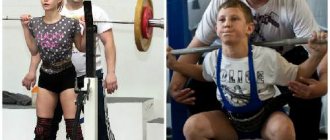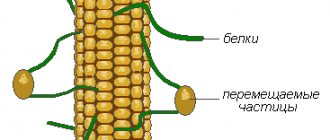| Kind of work: | Essay |
| Date added: | 21.01.2020 |
- This type of work is not a scientific work, it is not a finished final qualifying work!
- This type of work is a finished result of processing, structuring and formatting collected information intended for use as a source of material for independent preparation of educational work.
If you have a hard time understanding this topic, write to me on WhatsApp, we’ll look into your topic, agree on a deadline, and I’ll help you!
If you want to learn how to correctly carry out and write abstracts on any subject, then on the page “what is an abstract and how to do it” I wrote in detail.
High jump
The so-called royal jump over several horses standing nearby was popular among the ancient Germans. And for some tribes inhabiting Central Africa, from ancient times to the present day, the main event of folk festivals is high jump competitions. At the Olympic Games in Ancient Greece, Olympians ran, threw the discus, long jumped, wrestled, competed in chariots, fought in fist fights, but never high jumped in all 293 Olympiads. The first mentions of high jump sports competitions date back to the 19th century.
High jump owes its origin not so much to athletics as to gymnastics. In German gymnastics societies, athletes included in the program of their performances, along with such objects as rings, parallel bars, pommel horse, horizontal bar and high jump. And then they jumped from a straight run with two feet forward.
Chronicles of the 19th century mention the name of the jumper Karl Müller from Berlin. According to eyewitnesses, he was a strong, agile person and could easily jump over heights up to his chin. It's a shame that no one bothered to measure how high Karl Müller's chin is.
High jumping quickly spread throughout Europe. There were especially many of their fans in England. And there, at the first official competition in 1864, the winner, Robert Meich, jumped 1 meter in height. 67.4 cm.
However, a different result is considered the first world record. Medical student from London Robert Gooch in 1859 overcame the crossbar at a height of 1 m 70 cm. But the point here is not even the height, but the way Robert jumped. Unlike other athletes, he did not run at a right angle to the crossbar, but under a sharp one, from the side, and in the air his legs moved like scissors.
The run-up begins with the swing leg. It should be done at a fast pace and in an arced line. This line bends most in the last 3 steps of running. After pushing off, the pushing leg straightens very quickly, vertically upward. At this stage of the push-off, the back has not yet turned towards the bar. The fly's leg swings upward. She is bent at the knee joint, the jumper directs her forward, up and inward. Thanks to this, the jumper begins to turn with his back to the crossbar. The head turns over the shoulder from the side of the swing leg against the direction of movement. After takeoff, the relaxed swinging leg is brought to the pushing leg, which is also not under tension. The body straightens and thanks to this quickly turns its back to the crossbar, taking the desired position. With a sharp movement the body rushes forward. After this, the jumper’s shoulders are behind the crossbar and the jumper performs a deflection over the crossbar - a bridge. When the pelvis also passes through the bar, the hip joints quickly flex and the legs straighten. The jumper falls on the back, legs straight.
This method was invented by an American athlete named Dick Fosbury when he was 16 years old. In 1968, at the Summer Olympics in Mexico, Dick Fosbury won the Olympic gold medal using a new method, setting a new Olympic record (2.24 meters). Almost all modern high jumpers use the Fosbury flop.
Official Rules
Long jump results are determined along a straight axis perpendicular to the bar, starting from the take-off line and ending with the athlete’s trace (any part of the body). Exit from the pit is only allowed to the side or forward. The long jump rules invalidate the result if the athlete steps beyond the line parallel to the bar when taking off. Also, the final results are not counted if the athlete landed outside the pit or left a mark on the plasticine before the flight phase. The first touch of sand will be counted as an intermediate result.
In addition, the long jump rules determine the number of attempts that an athlete can make before his final (best) score is recorded. The number of so-called chances is limited to 6 times. The exception is competitions in which more than 8 athletes participate. In this case, conducts a qualifying round of 3 attempts for each jumper. 8 athletes with the best performance advance to the final stage.
Pole vaulting
Pole vaulting is a sport in which athletes compete in the height of their jump using long flexible poles (currently made from fiberglass or carbon fiber) to clear a horizontal bar mounted on two masts at considerable heights (up to 6 m or more). . Pole vaulting competitions were already held in Ancient Greece, as well as among the Celts and the inhabitants of ancient Crete. Men's pole vaulting has been an Olympic sport since the First Summer Olympics in 1896, and women's pole vaulting since the Sydney Olympics in 2000.
The world record in men's pole vaulting belongs to Sergei Bubka, who reached a height of 6 meters 14 centimeters on July 31, 1994. The world record in women's pole vault belongs to Elena Isinbayeva, who achieved a height of 5 meters 3 centimeters. July 11, 2008
In 2004, our girls won two medals - gold from Elena Isimbaeva and silver from Svetlana Feofanova.
Dos and don'ts during practice
The following points should be on your checklist while practicing −
- Until the takeoff point, maintain speed at all costs.
- As soon as you cross the board, increase your speed sharply.
- To maintain a more upright position, experiment with your running styles that work best for you.
- The compensatory action of the weapon must be done to give impetus.
- Landing exercises should be added to the training schedule.
Until the takeoff point, maintain speed at all costs.
As soon as you cross the board, increase your speed sharply.
To maintain a more upright position, experiment with your running styles that work best for you.
The compensatory action of the weapon must be done to give impetus.
Landing exercises should be added to the training schedule.
Here's what you shouldn't do:
- Just before takeoff, shortening or lengthening your stride.
- Without gaining much speed, take off from the hill.
- Tilt the trunk too far forward or backward.
- Imbalance during flight.
- The position of one leg lower than the other during the landing phase.
Just before takeoff, shortening or lengthening your stride.
Without gaining much speed, take off from the hill.
Tilt the trunk too far forward or backward.
Imbalance during flight.
The position of one leg lower than the other during the landing phase.
It is advisable to effectively practice sail technique to improve takeoff technique. Through this practice the upright torso will be maintained and the position of the free leg will be improved.
We can divide the basic jumps into three separate sections −
- An approach
- Take off
- Flight
Let's discuss these methods in detail and try to understand how to effectively apply them in our practice.
Long jump
At the beginning of the 20th century there was also a long jump.
Long jump is a discipline related to horizontal jumps of technical types of athletics. Requires athletes to do jumps and sprints. The long jump was part of the competition program of the ancient Olympic Games. It has been a modern Olympic track and field sport for men since 1896 and for women since 1948. It is part of the all-around track and field event.
The athlete’s task is to achieve the greatest horizontal length of the running jump. Long jumps are held in the horizontal jump sector according to the general rules established for this type of technical sports. When performing a jump, athletes at the first stage run along a track, then push off with one foot from a special board and jump into a pit with sand. The jump distance is calculated as the distance from a special mark on the take-off board to the beginning of the hole from landing in the sand.
The distance from the launch board to the far edge of the landing pit must be at least 10 m. The take-off line itself should be located at a distance of 1 to 3 m from the near edge of the landing pit.
Long jump is one of the most conservative sports. So, the 8-meter mark (8.13) for men was first overcome by Jesse Owens back in 1935, and to this day, with this result you can win major international competitions at the Grand Prix level.
Bob Beamon's 8.90m jump at the 1968 Mexico City Olympics is legendary. The previously unknown athlete surpassed the previous world record by 55 cm. This record was broken by Mike Powell in 1991 at the World Championships in Tokyo and remains unsurpassed to this day.
An absolute, but unconfirmed record in the history of the long jump was Mike Powell (USA) jumping 8.99 meters in one of his attempts at the 1991 World Championships finals in Tokyo. Cuban Ivan Pedroso's jump of 8.96 meters was also recorded. These jumps were not recognized as world records by the IAAF due to the fact that the wind speed exceeded 2 m/s or the wind speed itself was measured incorrectly.
In 2004, at the Olympics, the entire podium of women in this discipline was behind us! Tatyana Lebedeva, Irina Simagina and Tatyana Kotova listened to the Russian anthem - one for three.
Ryazan athlete Irina Simagina achieved great success at the Olympics in Athens. She won the silver medal in the long jump with a score of 7 meters 5 centimeters, losing to compatriot Tatyana Lebedeva. Oleg Konstantinovich Kapatsinsky trains an athlete.
How to land correctly
Preparation for this phase of the jump begins the moment the flight path begins to descend. At this moment it is important to group correctly. To be effective, you should hold your legs in such a position that their longitudinal projection is at the most acute angle to the horizontal surface.
The running long jump technique also involves proper contact with the landing area. At the same time, it is important to take care of leaving the flight phase. To do this, it is necessary to relax one leg, towards which the maneuver will be carried out, and at the moment of contact with the surface, turn the body. Care is carried out through the back (back), bringing both the shoulder and arm forward at the same time. It is worth noting that prematurely bringing the torso into this position can lead to lowering of the legs and early contact with the surface.
Triple jump
The men's triple jump has been part of the modern Olympic program since the beginning of the Olympic Games in 1896, and the 1900 and 1904 Olympics also featured standing triple jumps. James Connolly became the first modern Olympic champion in the men's triple jump. Since 1996, the triple jump has become an Olympic sport for women.
The best triple jumpers achieve results of about 18 m (for men) and about 15 m for women. World records currently belong to Jonathan Edwards (18.29 m) and Inessa Kravets (15.5 m).
Technically, the triple jump consists of three elements:
- "bounce"
- "step"
- "rebound"
The jumper runs along a special strip or path to a mark that serves for takeoff when jumping. This mark is the start of the jump when measuring its length, and the jump begins from this mark. First, the first element is performed - a jump, while the first touch beyond the mark should occur with the same foot with which the jumper began to jump. Then follows the second element of the jump - a step (the other leg should touch the ground). The final element is the jump itself, and the jumper lands in a sandbox, just like a long jump.
In practice, there are two ways to perform a jump: from the right foot - “right, right, left” and from the left foot - “left, left, right”. The mark for the jump outflow is located at a distance of at least 11 m from the sand pit. Each jumper is given 6 attempts to complete a triple jump.
Standards
In 2022, the following GTO standards for standing jumps have been established:
| Gender and age | Standards for obtaining a bronze badge, see | Standards for obtaining a silver badge, see | Standards for obtaining a gold badge, see |
| Women 18–24 years old | 170 | 180 | 195 |
| Men 18–24 years old | 215 | 230 | 240 |
| Women 25–29 years old | 165 | 175 | 190 |
| Men 25–29 years old | 225 | 230 | 240 |
| Women 30–34 years old | 160 | 170 | 185 |
| Men 30–34 years old | 220 | 225 | 235 |
| Women 35–39 years old | 150 | 165 | 180 |
| Men 35–39 years old | 210 | 215 | 225 |
Basics of jumping technique
Athletic jumping is divided into two types: vertical jumping (high jump and pole vault) and horizontal jumping (long jump and triple jump).
The effectiveness of a jump is determined in the take-off phase, when the main factors for the effectiveness of a jump are created. These factors include: the initial speed of the jumper’s body; the angle of departure of the jumper's body. The trajectory of the GCM in the flight phase depends on the nature of the repulsion and the type of jump. Additionally, the triple jump has three flight phases, and the pole vault has a supported and unsupported flight phase.
Athletics jumps are of a mixed type in their structure, that is, there are both cyclic and acyclic elements of movement.
As a holistic action, jumping can be divided into its component parts:
- take-off run and preparation for take-off - from the start of movement to the moment the pushing leg is placed at the take-off site;
- repulsion - from the moment the pushing leg is placed until it rises from the place of repulsion;
- flight - from the moment the pushing leg lifts off from the take-off point until contact with the landing site;
- landing - from the moment of contact with the landing site to the complete stop of body movement.
Takeoff run and preparation for takeoff. The four types of jumps (high jump, long jump, triple jump, pole vault) have their own characteristics during the run-up, but also have some common features. The main tasks of the take-off run are to give the jumper's body the optimal take-off speed corresponding to the jump, and to create optimal conditions for the take-off phase. Almost all types of jumps are straight, except for the high jump using the Fosbury flop method, where the last steps are performed in an arc.
The take-off run has a cyclic structure of movement before the start of preparation for take-off, in which the running movements are somewhat different from the movements during the take-off run. The take-off rhythm must be constant, i.e. it cannot be changed on a try.
Typically, the run-up corresponds to the physical capabilities of the athlete, which are observed in him at a given moment in time. Naturally, with the improvement of physical functions, the take-off will change, the speed and number of steps will increase (up to a certain limit), but the take-off rhythm will not change. These changes are associated with two main physical qualities of the jumper, which should be developed in parallel - speed and strength.
The start of the run should be familiar, always the same. The jumper can begin the takeoff run both from a place, both at the start, and from the approach to the control mark for the start of the takeoff run. The jumper’s task during the run-up is not only to gain optimal speed, but also to accurately reach the take-off point with the running leg, so the run-up, its rhythm and all movements must be constant.
There are two possible take-off options: uniformly accelerated take-off and take-off while maintaining speed. With a uniformly accelerated takeoff, the parachutist gradually picks up speed, increasing it to optimal speed in the final stages of the takeoff. During a run while maintaining speed, the jumper almost immediately gains optimal speed in the first steps, maintains it throughout the run, increasing slightly at the end in the last steps. The use of one or another running option depends on the individual characteristics of the jumper.
The distinctive features of the last part of the takeoff run (preparing for takeoff) depend on the type of jump. A common distinguishing feature is an increase in the take-off speed and movement of the body parts in this section of the take-off run, the so-called take-off run.
In running long jumps and running triple jumps, in preparation for takeoff, there is a slight decrease in the length of the last steps and an increase in their frequency.
In pole vaulting, in preparation for takeoff, the bar is moved forward, and the frequency of steps is increased while the step length is reduced.
In high jumps, this stage depends on the style of the jump. In all styles of running jumps in a straight line (“stepping”, “wave”, “rolling”, “throwing”), preparation for take-off occurs in the last two steps, when the swing leg takes a longer step, thereby reducing the GCM, and the running leg takes a shorter, quick step while the jumper's shoulders are pulled back behind the GCM lip. In the Fosbury Flop jump, preparation for take-off begins with the last four steps, performed in an arc with the body tilted away from the bar, where the last step is slightly shorter and the frequency of steps is increased.
It is very important to perform the takeoff preparation technique as efficiently as possible during the last part of the takeoff run. Take-off speed and take-off speed are interrelated. It is necessary that between the last steps and takeoff there are no stops or slowdowns or loss of speed. The faster and more efficiently the last part of the takeoff run is completed, the better the takeoff will be.
Knockback is the main phase of any jump. It lasts from the moment the running leg is placed on the support until it is removed from the support. In jumping, this stage is the shortest and at the same time the most important and active. From the point of view of biomechanics, repulsion can be defined as a change in the velocity vector of the jumper’s body when certain forces interact with the support. The repulsion phase can be divided into two parts: constructive and creative.
The first part creates the conditions for changing the velocity vector, and the second implements these conditions, i.e. creates the jump itself, its result.
One of the factors that determines the efficiency of horizontal to vertical speed conversion is the running leg angle. In all jumps, the leg is quickly, energetically and rigidly placed at the take-off site; at the moment the foot touches the support, it should be straightened at the knee joint. The approximate running leg angle is determined by the longitudinal axis of the leg, which connects the set to the ground line. In the high jump it is the smallest, then in increasing order are the triple jumps and the long jump, the largest angle is in the pole vault.
The more you need to convert the horizontal speed to vertical, the smaller (sharper) the angle of the leg position, the leg is placed further from the projection of the GCM. The rigid and fast stance of a straightened running leg is also due to the fact that a straight leg can more easily bear a heavy load, especially since the pressure on the support in the first part of the take-off is several times greater than the jumper’s body. weight. At the moment of grasping, the leg muscles are tense, which contributes to elastic shock absorption and more effective stretching of the elastic components of the muscles with the subsequent return (in the second part) of the energy of elastic deformation to the body. jumper. It is known from anatomy that tense muscles, when stretched, subsequently create greater muscle forces.
In the first part of the repulsion, there is an increase in the pressure forces on the support due to the horizontal speed and stopping movement of the pushing leg, the inertial forces of the movements of the swinging leg and arms; there is a decrease in GCM (the amount of decrease depends on the type of jump); Stretching of tense muscles and ligaments that are involved in the next part is performed.
In the second, creative, due to an increase in the reaction forces of the support, the velocity vector of the jumper’s body changes; the pressure forces on the support decrease towards the end of the repulsion; stretched muscles and ligaments transfer their energy to the jumper’s body; the inertial forces of the movements of the swinging leg and arms also take part in changing the vector of movement speed. All these factors create the initial speed of the jumper's body.
When characterizing the magnitude of muscular efforts at the moment of transferring part of the horizontal velocity to the vertical, it is necessary to talk not about the pure amount of effort, but about the impulse of force, i.e. the amount of force per unit. time. The greater the magnitude of the muscle efforts and the shorter the time of their manifestation, the higher the force impulse, which characterizes the explosive power of the muscles. Thus, in order to improve results in jumping, it is necessary to develop not just the strength of the leg muscles, but explosive power, characterized by a force impulse. This feature is clearly expressed when comparing the takeoff time in the high jump with the cross-over and fosbury styles. In the first style, the repulsion time is much longer than in the second, that is, in the first case there is a force repulsion, and in the second there is a high-speed (explosive) repulsion. The results of high jumps in the second case are higher. If we look at the anatomical features of these differences, we see that swing jumpers are larger, with more leg muscles, than Fosbury jumpers, which are lean and have less leg muscles.
The take-off angle depends on the angle of the running leg and the amount of muscle force during the transfer of speed, as discussed above.
Flight. This phase of the integral action of the jump is not supported for pole vaulting, where the flight is divided into two parts, with the exception of: support and unsupport.
It is necessary to immediately understand that during the flight phase the jumper can never change the trajectory of movement. Why does a jumper make various movements with his arms, legs, and change his body position in the air? Why study flying techniques? Answering these questions is the goal of this jumping phase. In the high jump, the athlete, through his movements, creates optimal conditions for clearing the bar. In pole vaulting, the first support part is the creation of optimal conditions for flexion and extension of the pole (for the most effective use of its elastic properties). The second unsupported part is to create optimal conditions for overcoming the crossbar. In long jumps, maintaining balance in flight and creating optimal conditions for landing. In the triple jump, the goal is to maintain balance and create optimal conditions for subsequent take-off, and in the last jump, the goal is the same as in the long jump.
Landing. Each jump ends with a landing phase. The purpose of any landing is, first of all, to create safe conditions for the athlete, eliminating various injuries.
At the moment of landing, the jumper’s body experiences a strong impact effect, which falls not only on the body parts that are in direct contact with the landing site, but also on the distal parts farthest from it. Internal organs are also subjected to the same shock, which can lead to various kinds of disruptions in their functioning and diseases. It is necessary to reduce the harmful effects of this factor. There are two ways: the first is to improve the landing site; the second is mastering the optimal landing technique. The first path was reflected in the high jump and pole vault. First, the athletes landed on sand, the level of which was raised above the take-off surface, but it was still difficult to land, and the athlete spent a lot of time mastering the technique of landing safely. Then came the era of foam rubber, and the landing site became much softer, the results increased, a new type of high jump (“Fosberry flop”) appeared, and fiberglass poles appeared. It became possible to spend more time on the jumps themselves, without thinking about landing.
A more conservative landing area remained in the long jump and triple jump. This is how they jumped into a sand pit, they continue to jump, although the results are growing, but the second way is reflected here - creating optimal conditions for landing and rational landing technique.
Why soft landing? The first is to land at a sharper angle to the surface and on a longer path. By gradually compacting the loose sand, the athlete slows down the forward movement; the more loose sand there is in front, the softer the landing. The second is due to the shock-absorbing stretching of tense muscles, gradually yielding to the action of gravity and body speed, while the speed is not suddenly extinguished, but gradually.
How to do a run-up correctly
The main indicator of this action is speed. The range of his flight, that is, the final result, directly depends on how quickly the athlete runs. Each athlete chooses the distance to the take-off point and the number of steps taken. These are individual characteristics that are based on the physical characteristics of the jumper. Professional athletes take approximately 22-24 steps when running at a distance of 50 m. For women, the distance from the starting point to the take-off line is 40 m. They conquer this distance in 20-22 steps. In amateur categories (for example, physical education), long jumps begin with a run of 20 m. In this case, the number of steps taken is not taken into account. The run-up is conventionally divided into 3 components: start, acceleration and preparation for take-off. The first stage can be from a standing position or from an approach. The start of the run sets the further pace and strength of the jump, so special attention must be paid to it. When starting from a standing position, the athlete begins moving from a specific mark, placing one leg in front of him and the other back on his toe. The important point here is the swing. When moving the body back and forth, the athlete deliberately shifts the center of gravity, establishing optimal balance. Starting from an approach requires hitting a control point with a certain foot, after which the run-up begins to be taken into account according to generally accepted rules.
When picking up speed, the amplitude of the legs and arms should be as wide as possible. It is important that the tilt of the body reaches 80 degrees. By the end of the acceleration, the body should take a vertical position. During the run, you must move strictly in a straight line, so that later you can push off comfortably and strongly from the track. A few steps before the start of the jump, the acceleration speed should be maximum. At this time, the shoulders should be tilted back and the pelvis should be pushed forward much further.










